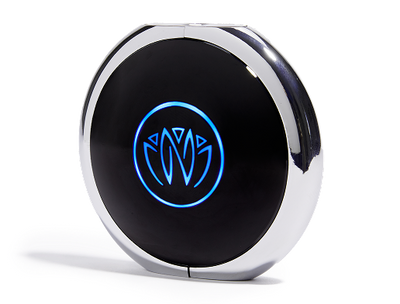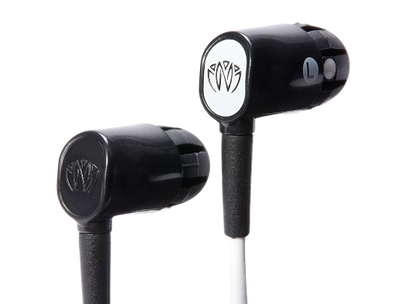At first thought, hearing "vagus nerve stimulation" could trigger images of invasive and intense procedures to achieve it. But the truth is, there are all kinds of non-invasive options for stimulating the vagus nerve. For even more good news, they're much more accessible than you might realize. This blog post breaks down some of the many practices and methods of non-invasive vagus nerve stimulation (nVNS). We'll also discuss the benefits of vagus nerve stimulation in general and much more.
So, if you're here because you just heard about VNS or are ready to take a deeper dive, keep reading to gain a comprehensive understanding of the basics.
What is the Vagus Nerve?
The vagus nerve is a crucial part of the body's autonomic nervous system. It’s essential in regulating heart rate, digestion, respiration, and other involuntary processes. It connects to virtually all of your major organs and sends a variety of information from your body to the brain. Notably, this includes the gut-brain axis and your body's inflammatory responses. Stimulating the vagus nerve can therefore have a powerful impact on physical and mental health, which is why so many people turn to VNS for relief from certain illnesses and conditions.
Unfortunately, however, many people have underactive vagus nerves that lack tone. In turn, they can experience a number of adverse side effects.
Symptoms of low vagal tone
Certain signs and symptoms can indicate one has a low vagal tone.
These include:
- Anxiety, depression, or other mood disorders
- Poor digestive health
- Chronic fatigue
- Low immune function
- Insomnia
- High blood pressure
- Heart problems
Of course, these can all be symptoms of or related to other conditions as well. If you experience the above, speak with your doctor to determine the best course of action.
Another sign that your vagus nerve lacks tone is when your nervous system feels like it's in overdrive. As a result, you might be in a near-constant state of fight or flight mode. This could mean it's time to rest and digest!
Rest and Digest
We mentioned the vagus nerve is part of the autonomic nervous system and part of the parasympathetic branch. This is also called your "rest and digest" response. That's because it slows down the heart rate and breathing while activating salivation, digestion, and other activities associated with relaxation. When stimulated non-invasively, VNS can trigger this system, leading to feelings of restfulness and general well-being.
For example, if you find yourself in a constant state of "fight or flight," even when you're not actively facing a threat, non-invasive vagus nerve stimulation can help activate the restful "rest and digest" activity. This can lead to a feeling of calmness, which helps your body heal and recover from chronic stress or illness.
Now that we know a bit more about the vagus nerve and its role in the body, we can move on to discuss some of the different non-invasive VNS techniques.
Vagus Nerve Stimulation: 101
There are many different measures to stimulate the vagus nerve non-invasively. Alternatively, there are also more invasive measures worth discussing before we talk about how to use them. Solutions like vagus nerve stimulation implants are available, which involve surgically implanting electrical stimulation devices directly into the nerve itself. This is similar to a pacemaker, but the device stimulates the vagus nerve instead of the heart.
The implant is typically placed into the chest, near where the vagus nerve passes through, and then hooks up to a power source that can be controlled externally.
The Mayo Clinic explains:
"In conventional vagus nerve stimulation, a device is surgically implanted under the skin on your chest, and a wire is threaded under your skin connecting the device to the left vagus nerve. When activated, the device sends electrical signals along the left vagus nerve to your brainstem, which then sends signals to certain areas in your brain. The right vagus nerve isn't used because it's more likely to carry fibers that supply nerves to the heart."
Surgical VNS has been proven to be effective for certain conditions, though it's still relatively rare due to its highly invasive nature.
That's why more invasive measures are used for treating serious medical conditions like epilepsy, gastroparesis, and treatment-resistant depression—the benefits for those suffering from these debilitating conditions can be life-changing. But invasive methods aren't necessary for those who want to improve their overall well-being and wellness and don't have a serious medical condition to treat.
Luckily, no surgery is required to reap the rewards of VNS!
Non-Invasive Vagus Nerve Stimulation (nVNS)
Here are eight of the most effective and accessible non-invasive options for stimulating the vagus nerve.
Xen by Neuvana vagus nerve-stimulating headphones
Neuvana's Xen headphones are made to stimulate the vagus nerve while you listen to your favorite music or sounds or even silence. It stimulates the auricular branch of the vagus nerve, sending a tiny electrical signal through the earbuds.
Users can stimulate their vagus nerve while they go about their day, relax, or get creative. Most users report that the Xen headphones help reduce anxiety, boost their cognition, promote faster recovery, and create an overall brighter mood, among other benefits.
What's particularly exciting about this option is that it's completely non-invasive, meaning there's no need for surgery. In addition, the Xen headphones are easy to use and can be taken with you wherever you go. Not to mention, they're incredibly effective!
Cold exposure
It's become all the rage lately, and when you consider the benefits of cold therapy, it's no surprise!
Cold therapy can stimulate the vagus nerve by activating certain temperature-sensitive receptors found in your skin and other organs. This technique involves exposing yourself to cold temperatures (in the form of ice packs, cold showers, cold plunges, etc.) for short periods of time to activate your body's natural "rest and digest" system.
Wim Hof, a big proponent of cold therapy, explains on his website:
"Frequent exposure to cold is linked to a number of different health benefits. For example, scientists have found evidence that exposure to cold speeds up metabolism. Another benefit of exposing your body to cold is that it reduces inflammation, swelling, and sore muscles. Therefore, many athletes use ice baths and other types of exposure to cold as a means to speed up recovery after physical exercise. Furthermore, cold body therapy is also linked to improved quality of sleep, more focus, and even an improved immune response."
Singing, humming, and gargling
The vagus nerve passes through the neck, which means the vocal cords can be used to stimulate it. This can be done through singing, humming, or gargling.
Singing and humming are particularly effective because they require a certain amount of breath control that activates the vagus nerve and kicks off the relaxation response. In fact, there is even a type of therapy known as "singing for health" that uses voice exercises to reduce stress and anxiety levels in patients with chronic illnesses.
Gargling is another option for stimulating your vagus nerve. The sound and vibration from gargling stimulate the afferent fibers in your vocal cords, which then send signals to the brain by way of your vagus nerve. Again, doing this will help you relax and reduce stress levels.
Meditation and yoga
It's no secret that meditation and yoga come with a host of mental and physical health benefits—and they can also help you stimulate your vagus nerve. Both practices require deep breathing and body awareness, which activates your parasympathetic nervous system (which includes your vagus nerve).
Studies have found that meditating regularly can enhance emotional regulation, reduce anxiety levels, promote relaxation, improve cardiovascular function, boost immunity, and more. And regarding yoga specifically: research has shown it to be an effective treatment for depression, anxiety, and chronic pain.
So if you want a way to stimulate your vagus nerve and reap the associated health benefits—meditation and yoga are two options you don't want to skip!
Acupuncture
Acupuncture has been used as a type of treatment in traditional Chinese medicine for centuries. And according to modern science, it's effective at stimulating the vagus nerve! This is because acupuncture helps balance out your body's energy levels by targeting specific points on the skin - which are connected to different body areas via energy pathways that lead back up to the brainstem (where the vagus nerve originates).
Numerous studies show acupuncture can help reduce stress, improve immunity, lower inflammation, enhance sleep quality, and more. There's also exciting research about acupuncture's efficacy in treating chronic pain.
Check out the findings from this 2013 study on VNS and acupuncture, too that:
"Demonstrated marked correspondences of the indications for those lateral head and neck acupoints to the clinical effects (beneficial and adverse) documented for the VNS device in the medical literature. This clinical correspondence, in conjunction with the anatomic proximity of the acupoints to the vagus nerve in the lateral neck, strongly suggests that vagus nerve (and hence the autonomic nervous system) stimulation is fundamental in producing the clinical effects of the acupoints."
Massage
Massage, including neck and ear massage, can stimulate your vagus nerve and create a sense of relaxation. Further, massage therapy can reduce muscle tension, activating the parasympathetic nervous system (and thus the vagus nerve).
When the vagus nerve is targeted directly with massage, it can help reduce inflammation, relieve anxiety symptoms, and improve digestion. Plus, studies have found massage to be an effective treatment for chronic pain and headaches as well.
Here's a helpful guide to vagus nerve massage if you're ready to try it.
The vagus nerve diet
Another attractive and often overlooked option for toning and stimulating the vagus nerve is by including certain foods in your diet. Although a "vagus nerve diet" isn't as clearly defined as some diets (like keto) might be, there are some helpful guidelines to follow.
As this article from the Dr. Ruscio blog highlights:
"What we do know is that dietary choices that are generally good for your health seem to also benefit vagal tone and support a healthy vagus nerve. We can also infer that diets that specifically promote good gut health may improve vagal tone, since the vagus nerve can sense inflammation and microbial metabolites (like butyrate) in the gut."
It also includes a list of some of the foods that could be most beneficial for promoting healthy vagal activity:
- Omega-3 fatty acids
- Mediterranean diet (rich in fruits, vegetables, grains, legumes, nuts, and fish)
- Enriched yogurt
- Pistachios
- Probiotic foods/supplements
- Polyphenol-rich red wine (not spirits or beer)
- Adequate vitamin B12
- High-choline foods
Vagus nerve tapping
Tapping is a form of psychological acupressure that is said to help reduce stress, anxiety, and physical pain. It's based on the same meridian points used in acupuncture, and when done correctly, it can be an effective option for stimulating your vagus nerve.
Vagus nerve tapping usually entails gently tapping behind the earlobe near the mastoid process (where the skull meets the neck) or over different areas of your face. This helps activate the pressure points associated with calming down the nervous system, which stimulates your vagus nerve!
Benefits of Vagus Nerve Stimulation
Although we've touched on some of the benefits of vagus nerve stimulation already, here's a review of what you might expect from toning your vagus nerve:
Reduced anxiety
Many people find vagus nerve stimulation can be an effective treatment for depression and anxiety. Regular VNS treatments can encourage your body to produce more chemicals associated with relaxation (including serotonin), helping you better manage stress levels. In serious cases, as we mentioned, this might mean turning to surgical devices. But for general anxiety and mood-boosting effects, non-invasive methods can be an excellent alternative.
Improved digestion
The vagus nerve controls a lot of the digestive process, from how much stomach acid is released to when food passes through your intestines. In turn, you might experience bloating, constipation, and other digestive issues when it's not functioning correctly. Stimulating your vagus nerve helps regulate this process, promoting healthy gut flora and reducing uncomfortable symptoms.
Better heart health
Your vagus nerve also plays a role in controlling your heart rate. If it's not functioning correctly, you might be at risk of developing an irregular heartbeat or worse. Vagus nerve stimulation can help lower your heartbeat if it's too high, keeping it steady and helping reduce the risk of conditions like arrhythmia and hypertension.
Enhanced immunity and lower inflammation
Research has also suggested that regular VNS treatments can improve your immune system by increasing the production of antibodies in response to infection and disease. And since inflammation is considered a significant cause of autoimmune disorders, it could also reduce the risk (or effect) of certain conditions, including rheumatoid arthritis.
Reduced chronic pain symptoms
Chronic pain is something many of us suffer with daily and can be both physically and mentally draining. Fortunately, studies have shown that VNS can be a helpful way to manage chronic pain symptoms. Studies suggest it helps activate the brain's natural 'pain-relief' pathways, relieving conditions like migraines or fibromyalgia.
Here's what one 2018 study found on the subject:
"The applications of VNS also extend to widespread inflammatory disorders associated with chronic or intermittent bouts of pain such as fibromyalgia and migraines. Lange et al. conducted a Phase I/II clinical trial to assess VNS as an adjunct treatment for patients with fibromyalgia due to its effects on serotonergic and noradrenergic neural circuits – both of which are implicated in pain sensation.56 Their theory was based on results from patients with depression treated with VNS who reported decreased sensation of pain.57 Lange et al.'s study included 12 women with fibromyalgia and used the same stimulus parameters as for treatment of epilepsy. After 11 months, 7 of the patients had the minimum clinical difference (MCID+) in their pain symptoms for VNS to be considered effective.56
Overall well-being
Whether you're seeking relief from anxiety, digestive issues, sleep woes or just want to boost your health and well-being, non-invasive vagus nerve stimulation might be right for you. Regular treatments might reduce stress levels and boost immunity, improve digestion and heart health, and even provide anti-inflammatory benefits.
Plus, since this non-invasive treatment has no significant side effects, it's safe for most people to try. It's always best to consult your doctor before making any changes to your healthcare routine, though - they'll be able to offer the best advice for your specific needs.
Final Thoughts on Non-Invasive Vagus Nerve Stimulation
There are so many reasons to consider implementing non-invasive vagus nerve stimulation into your daily routine and the science-backed benefits make it an attractive option for many. Not only is it a safe treatment, but it's also relatively inexpensive and easy to do - no matter where you are or what you're up to.
Shop Xen by Neuvana today if you're interested in trying an effective and non-invasive vagus nerve stimulation device.





